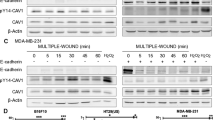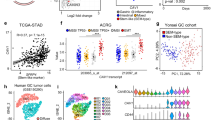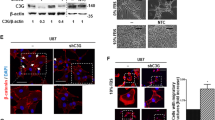Abstract
Epidermal growth factor receptor (EGFR) amplification and type III mutation (EGFRvIII), associated with constitutive tyrosine kinase activation and high malignancy, are commonly observed in glioblastoma tumors. The association of EGFR and EGFRvIII with caveolins was investigated in human glioblastoma cell lines, U87MG and U87MG-EGFRvIII. Caveolin-1 expression, determined by RT–PCR, real-time quantitative PCR and Western blot, was upregulated in glioblastoma cell lines (two-fold) and tumors (20–300-fold) compared to primary human astrocytes and nonmalignant brain tissue, respectively. U87MG-EGFRvIII expressed higher levels of caveolin-1 than U87MG. In contrast, the expression of caveolin-2 and -3 were downregulated in glioblastoma cells compared to astrocytes. A colocalization of EGFR, but not of EGFRvIII, with lipid rafts and caveolin-1 was observed by immunocytochemistry. Association of EGFR and EGFRvIII with caveolae, assessed in vitro by binding to caveolin scaffolding domain peptides and in vivo by immunocolocalization studies in cells and caveolae-enriched cellular fraction, was phosphorylation-dependent: ligand-induced phosphorylation of EGFR resulted in dissociation of EGFR from caveolae. In contrast, inhibition of the EGFRvIII constitutive tyrosine phosphorylation by AG1478 increased association of EGFRvIII with caveolin-1. AG1478 also increased caveolin-1 expression and reduced glioblastoma cell growth in a semi-solid agar. The evidence suggests that the phosphorylation-regulated sequestration of EGFR in caveolae may be involved in arresting constitutive or ligand-induced signaling through EGFR responsible for glial cell transformation.
This is a preview of subscription content, access via your institution
Access options
Subscribe to this journal
Receive 50 print issues and online access
$259.00 per year
only $5.18 per issue
Buy this article
- Purchase on Springer Link
- Instant access to full article PDF
Prices may be subject to local taxes which are calculated during checkout









Similar content being viewed by others
References
Anderson RG . (1998). Annu. Rev. Biochem., 67, 199–225.
Bender FC, Reymond MA, Bron C and Quest AF . (2000). Cancer Res., 60, 5870–5878.
Cameron PL, Liu C, Smart DK, Hantus ST, Fick JR and Cameron RS . (2002). Glia, 37, 275–290.
Chen X and Resh MD . (2002). J. Biol. Chem., 277, 49631–49637.
Couet J, Sargiacomo M and Lisanti MP . (1997). J. Biol. Chem., 272, 30429–30438.
Ekstrand AJ, Liu L, He J, Hamid ML, Longo N, Collins VP and James CD . (1995). Oncogene, 10, 1455–1460.
Emrich JG, Brady LW, Quang TS, Class R, Miyamoto C, Black P and Rodeck U . (2002). Am. J. Clin. Oncol., 25, 541–546.
Engelman JA, Chu C, Lin A, Jo H, Ikezu T, Okamoto T, Kohtz DS and Lisanti MP . (1998a). FEBS Lett., 428, 205–211.
Engelman JA, Lee RJ, Karnezis A, Bearss DJ, Webster M, Siegel P, Muller WJ, Windle JJ, Pestell RJ and Lisanti MP . (1998b). J. Biol. Chem., 273, 20448–20455.
Forget MA, Desrosiers RR, Del M, Moumdjian R, Shedid D, Berthelet F and Beliveau R . (2002). Clin. Exp. Metast., 19, 9–15.
Galbiati F, Volonte D, Engelman JA, Watanabe G, Burk R, Pestell RG and Lisanti MP . (1998). EMBO J., 17, 6633–6648.
Ge G, Wu J and Lin Q . (2001). Biochem. Biophys. Res. Commun., 282, 511–514.
Glenney JR and Soppet D . (1992). Proc. Natl. Acad. Sci. USA, 89, 10517–10521.
Han Y, Caday CG, Nanda A, Cavenee WK and Huang HJ . (1996). Cancer Res., 56, 3859–3861.
Harder T, Scheiffele P, Verkade P and Simons K . (1998). J. Cell Biol., 141, 929–942.
Jakobisiak M and Golab J . (2003). Int. J. Oncol., 23, 1055–1069.
Janes PW, Ley SC and Magee AI . (1999). J. Cell. Biol., 147, 447–461.
Jungbluth AA, Stockert E, Huang HJ, Collins VP, Coplan K, Iversen K, Kolb D, Johns TJ, Scott AM, Gullick WJ, Ritter G, Cohen L, Scanlan MJ, Cavenee WK and Old LJ . (2003). Proc. Natl. Acad. Sci. USA, 100, 639–644.
Kanzaki M and Pessin JE . (2002). J. Biol. Chem., 277, 25867–25869.
Kato K, Hida Y, Miyamoto M, Hashida H, Shinohara T, Itoh T, Okushiba S, Kondo S and Katoh H . (2002). Cancer, 94, 929–933.
Kim YN, Wiepz GJ, Guadarrama AG and Bertics PJ . (2000). J. Biol. Chem., 275, 7481–7491.
Kleihues P and Ohgaki H . (1999). Neuro-oncology, 1, 44–51.
Ikezu T, Ueda H, Trapp BD, Nishiyama K, Sha JF, Volonte D, Galbiati F, Byrd AL, Bassell G, Serizawa H, Lane WS, Lisanti MP and Okamoto T . (1998). Brain Res., 804, 177–179.
Lisanti MP, Scherer PE, Vidugiriene J, Tang Z, Hermanowski-Vosatk A, Tu YH, Cook RF and Sargiacomo M . (1994). J. Cell. Biol., 126, 111–126.
Mamot C, Drummond DC, Greiser U, Hong K, Kirpotin DB, Marks JD and Park JW . (2003). Cancer Res., 63, 3155–3161.
Mineo C, Gill CN and Anderson RG . (1999). J. Biol. Chem., 274, 30636–30643.
Mineo C, James GL, Smart EJ and Anderson RG . (1996). J. Biol. Chem., 271, 11930–11935.
Mischel PS and Cloughesy TF . (2003). Brain Pathol., 13, 52–61.
Nagane M, Lin H, Cavenee WK and Huang HJ . (2001). Cancer Lett., 162, S17–S21.
Narita Y, Nagane M, Mishima K, Huang HJ, Furnari FB and Cavenee WK . (2002). Cancer Res., 62, 6764–6768.
Nishikawa AR, Ji XD, Harmon RC, Lazar CS, Gill GN, Cavenee WK and Huang HJ . (1994). Proc. Natl. Acad. Sci. USA, 91, 7727–7731.
Nishiyama K, Trapp BD, Ikezu T, Ransohoff RM, Tomita T, Iwatsubo T, Kanazawa I, Hsiao KK, Lisanti MP and Okamoto T . (1999). J. Neurosci., 19, 6538–6548.
Okamoto T, Schlegel A, Scherer PE and Lisanti MP . (1998). J. Biol. Chem., 273, 5419–5422.
Racine C, Belanger M, Hirabayashi H, Boucher M, Chakir J and Couet J . (1999). Biochem. Biophys. Res. Commun., 255, 580–586.
Razani B, Schlegel A, Liu J and Lisanti MP . (2001). Biochem. Soc. Trans., 29, 494–499.
Ringerike T, Blystad FD, Levy FO, Madshus IH and Stang E . (2002). J. Cell. Sci., 115, 1331–1340.
Scherer PE, Lewis RY, Volonte D, Engelman JA, Galbiati F, Couet J, Kohtz DS, van Donselaar E, Peters P and Lisanti MP . (1997). J. Biol. Chem., 272, 29337–29346.
Schlegel A, Pestell RG and Lisanti MP . (2000). Front. Biosci., 5, 929–937.
Schmidt MH, Furnari FB, Cavenee WK and Bogler O . (2003). Proc. Natl. Acad. Sci. USA, 100, 6505–6510.
Shaul PW and Anderson RG . (1998). Am. J. Physiol., 275, L843–851.
Smart EJ, Ying YS, Mineo C and Anderson G . (1995). Proc. Natl. Acad. Sci. USA, 92, 10104–10108.
Stang E, Johannessen LE, Knardal SL and Madshus IH . (2000). J. Biol. Chem., 275, 13940–13947.
Thompson TC . (1998). Cancer Metast. Rev., 17, 439–442.
Voldborg BR, Damstrup L, Spang-Thompsen M and Poulsen HS . (1997). Ann. Oncol., 8, 1197–1206.
Wiechen K, Sers C, Agoulnik A, Arlt K, Dietel M and Schlag PM . (2001). Am. J. Pathol., 158, 833–839.
Worm K, Dabbagh P and Schwechheimer K . (1998). Hum. Pathol., 30, 222–227.
Yang G, Truong LD, Timme TL, Ren C, Wheeler TM, Park SH, Nasu Y, Bangm ACH, Kattan MW, Scardino PT and Thompson TC . (1998). Clin. Cancer Res., 4, 1873–1880.
Yong W . (1992). J. Neurol. Sci., 111, 92–103.
Zhang R, Tremblay T-L, McDermid A, Thibault P and Stanimirovic D . (2003). Glia, 42, 194–208.
Acknowledgements
We thank Dr Robert Monette for his valuable help with confocal microscopy, and Dr Gordon Willick for synthesis of caveolin scaffolding domain peptides.
Author information
Authors and Affiliations
Corresponding author
Rights and permissions
About this article
Cite this article
Abulrob, A., Giuseppin, S., Andrade, M. et al. Interactions of EGFR and caveolin-1 in human glioblastoma cells: evidence that tyrosine phosphorylation regulates EGFR association with caveolae. Oncogene 23, 6967–6979 (2004). https://doi.org/10.1038/sj.onc.1207911
Received:
Revised:
Accepted:
Published:
Issue Date:
DOI: https://doi.org/10.1038/sj.onc.1207911
Keywords
This article is cited by
-
IGF-1 Combined with OPN Promotes Neuronal Axon Growth in Vitro Through the IGF-1R/Akt/mTOR Signaling Pathway in Lipid Rafts
Neurochemical Research (2023)
-
Lipid Raft Facilitated Receptor Organization and Signaling: A Functional Rheostat in Embryonic Development, Stem Cell Biology and Cancer
Stem Cell Reviews and Reports (2023)
-
Application of blood brain barrier models in pre-clinical assessment of glioblastoma-targeting CAR-T based immunotherapies
Fluids and Barriers of the CNS (2022)
-
Caveolin1 Tyrosine-14 Phosphorylation: Role in Cellular Responsiveness to Mechanical Cues
The Journal of Membrane Biology (2020)
-
Apoptosis of cancer cells is triggered by selective crosslinking and inhibition of receptor tyrosine kinases
Communications Biology (2019)



